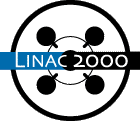
Ji Qiang, Robert D. Ryne (LANL)
In this paper, we present results of using parallel supercomputers to simulate beam dynamics in next-generation high intensity ion linacs. These are among the most detailed linac simulations ever performed, using up to 500 million macroparticles, which is close to the number of particles in the physical systems considered. Our approach uses a fully three-dimensional space charge calculation. It also uses an improved model of beam dynamics within the rf cavities that is more accurate and flexible than the usual treatment based on approximate field integrals. The simulations use a hybrid approach involving transfer maps to treat externally applied fields and parallel particle-in-cell techniques to treat the space-charge fields. Our approach is ideally suited to modeling superconducting linacs (where there are only a few types of cavities to be modeled), but we have also performed simulations of room-temperature linacs that involved modeling over 400 cavities. Traditionally, small-scale two-dimensional simulations have been performed on PCs or workstations. While such simulations are sufficient for rapid design and for predicting root mean square properties of the beam, large-scale simulations are essential for modeling the low-density tails of the beam. The large-scale parallel simulation results presented here represent a three order of magnitude improvement in simulation capability, in terms of problem size and speed of execution, compared with typical two-dimensional serial simulations. In this paper we will show how large scale simulations can be used to predict the extent of the beam halo and facilitate design decisions related to the choice of beam pipe aperture. Specific examples will be presented, including simulation of the spallation neutron source linac and the Low Energy Demonstrator Accelerator (LEDA) beam halo experiment.
Comments or Questions to
linac2000@slac.stanford.edu